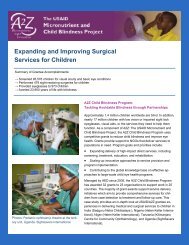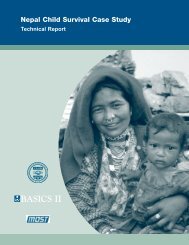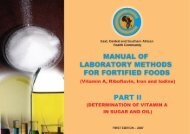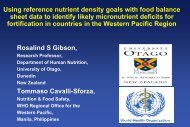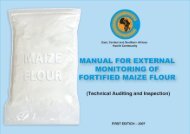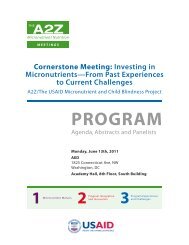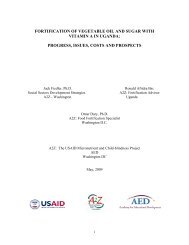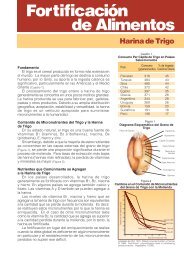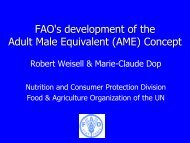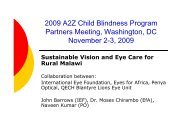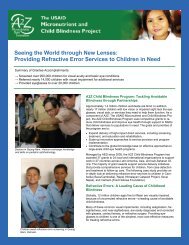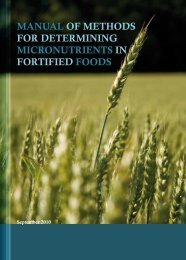Vitamin A Global Initiative - A2Z: The USAID Micronutrient and Child ...
Vitamin A Global Initiative - A2Z: The USAID Micronutrient and Child ...
Vitamin A Global Initiative - A2Z: The USAID Micronutrient and Child ...
You also want an ePaper? Increase the reach of your titles
YUMPU automatically turns print PDFs into web optimized ePapers that Google loves.
GLOBAL INITIATIVE<br />
About vitamin A deficiency<br />
Every year, 11.3 million children under 5 years old die in the developing<br />
world, over six million of them directly or indirectly from malnutrition.<br />
Millions more children are malnourished. Less strong <strong>and</strong> less<br />
healthy than they should be, they have fewer opportunities to reach<br />
their full potential in life.<br />
<strong>The</strong> problem of vitamin A deficiency (VAD) is global. It affects more<br />
than 100 million children <strong>and</strong> is responsible for as many as one out<br />
of every four child deaths in regions, countries <strong>and</strong> communities<br />
where the problem exists. Now, there is also more <strong>and</strong> more evidence<br />
that VAD increases the risk of maternal death.<br />
<strong>Vitamin</strong> A is essential for the functioning of the immune system.<br />
Giving vitamin A supplements to children who need them increases<br />
their resistance to disease, <strong>and</strong> improves their chances for survival,<br />
growth <strong>and</strong> development.<br />
Safety of vitamin A<br />
supplements<br />
Concerns have been<br />
expressed in many countries<br />
about the dangers of toxicity<br />
of high-dose vitamin A supplementation.<br />
But the benefits<br />
of vitamin A supplementation<br />
far outweigh any side<br />
effects, which are transient<br />
<strong>and</strong> very rare.<br />
Most vitamin A supplementation<br />
programmes use highdose<br />
capsules. <strong>The</strong>se doses<br />
are completely safe for children<br />
when given at least a<br />
month apart. Safe lower<br />
doses have been established<br />
for pregnant women.<br />
In the past, VAD has been seen<br />
merely as a cause of blindness,<br />
<strong>and</strong> in many countries vitamin<br />
A activities are still limited to<br />
blindness prevention programmes.<br />
In other countries, no<br />
action has been taken <strong>and</strong> no<br />
assessment of the problem<br />
exists. About 30 countries will<br />
achieve the Year 2000 goal of<br />
elimination of VAD. Many more<br />
will not.<br />
It is now clear that elimination<br />
of VAD as a public health problem<br />
must be a principal element<br />
of child survival <strong>and</strong><br />
maternal survival programmes<br />
where the problem exists.<br />
Eliminating VAD as a public<br />
health problem is a challenge the<br />
world must take on today.<br />
REASONS FOR ACTION<br />
Improving vitamin A status of<br />
deficient children increases their<br />
chances of survival:<br />
■ Death from measles can be<br />
reduced by 50 per cent<br />
■ Death from diarrhoea can be<br />
reduced by 40 per cent<br />
■ Overall mortality can be<br />
reduced by 25 per cent<br />
Improving vitamin A status of<br />
children reduces the severity of<br />
childhood illnesses:<br />
■ Less strain on clinic <strong>and</strong> outpatient<br />
services<br />
■ Fewer hospital admissions<br />
■ Contributes to the well-being of<br />
children <strong>and</strong> families<br />
Improving vitamin A status also:<br />
■ Prevents night blindness,<br />
xerophthalmia, corneal destruction<br />
<strong>and</strong> blindness<br />
■ May reduce birth defects<br />
■ May prevent epithelial <strong>and</strong> perhaps<br />
other types of cancer<br />
Improving vitamin A status may<br />
reduce maternal mortality:<br />
■ Improves resistance to infection<br />
■ Helps reduce anemia<br />
Improving vitamin A status is<br />
very cost-effective:<br />
■ Just a few cents per capsule<br />
■ Reduces health costs by lessening<br />
hospital <strong>and</strong> clinic visits<br />
■ Easily integrated into existing<br />
public health/immunization<br />
programmes
Action need not wait for assessment<br />
Many countries or regions may not realize that VAD is a problem,<br />
since they do not have up-to-date national-level assessments of the<br />
prevalence of VAD.<br />
National-level assessments should take place as soon as possible in all<br />
countries that do not have such assessments. But action to eliminate<br />
VAD should not wait for the results of these surveys.<br />
Some countries have carried out assessments using ocular indicators,<br />
such as Bitot’s spots. However, these ocular signs are associated with<br />
advanced stages of VAD. Women <strong>and</strong> children may be at needlessly<br />
high risk of dying long before any eye problems are evident.<br />
A high infant-mortality or under-five mortality rate (U5MR>70)<br />
should be taken as an indicator of a likely VAD problem, especially<br />
if it is also known that overall child malnutrition <strong>and</strong> low<br />
birthweights are prevalent <strong>and</strong> consumption of vitamin A-rich<br />
foods is low.<br />
Governments in countries with high infant or child mortality<br />
should work with partners to put in place a programme for control<br />
of VAD, including assessment of the problem, as part of a<br />
comprehensive strategy to reduce child mortality.<br />
PROGRAMME ACTIVITIES<br />
<strong>The</strong>re are a number of ways to improve<br />
the vitamin A status of populations.<br />
<strong>Vitamin</strong> A-rich foods are not always<br />
readily accessible to people who need<br />
them. In many parts of the industrialized<br />
world, food products are fortified<br />
to ensure that populations receive adequate<br />
amounts of the vitamin. In many<br />
countries, children <strong>and</strong> adults alike<br />
take daily vitamin supplements. <strong>The</strong><br />
following are the fastest <strong>and</strong> most<br />
cost-effective approaches to improving<br />
vitamin A status of populations.<br />
<strong>Vitamin</strong> A supplements can end VAD<br />
as a public health problem.<br />
Supplementation is:<br />
■ cost-effective<br />
■ safe<br />
■ sustainable<br />
■ easily implemented on a national scale<br />
■ can be carried out for many years<br />
Supplementation using vitamin A capsules<br />
should begin at six months old in<br />
areas where children do not get<br />
enough vitamin A in their diets.<br />
Mortality reduction potential is very<br />
high, <strong>and</strong> the benefits of high-dose<br />
supplements far outweigh the very rare<br />
<strong>and</strong> transient side effects. Capsules<br />
cost just a few cents each <strong>and</strong> can be<br />
distributed through exp<strong>and</strong>ed programmes<br />
on immunization, National<br />
Immunization Days or other public<br />
health contacts.<br />
Breastfeeding support is key to reducing<br />
VAD among young children. New<br />
mothers should receive a high-dose vitamin<br />
A supplement within 8 weeks of<br />
delivery in areas where deficiency exists.<br />
In some countries, where industrial <strong>and</strong><br />
commercial infrastructure is adequate,<br />
fortification of food staples like flour,<br />
sugar <strong>and</strong> margarine can help end VAD.<br />
Fortification can be very cost-effective.<br />
Dietary improvement, including ensuring<br />
regular access to foods that are naturally<br />
rich in vitamin A, will be part of a<br />
long-term-strategy in many countries.



